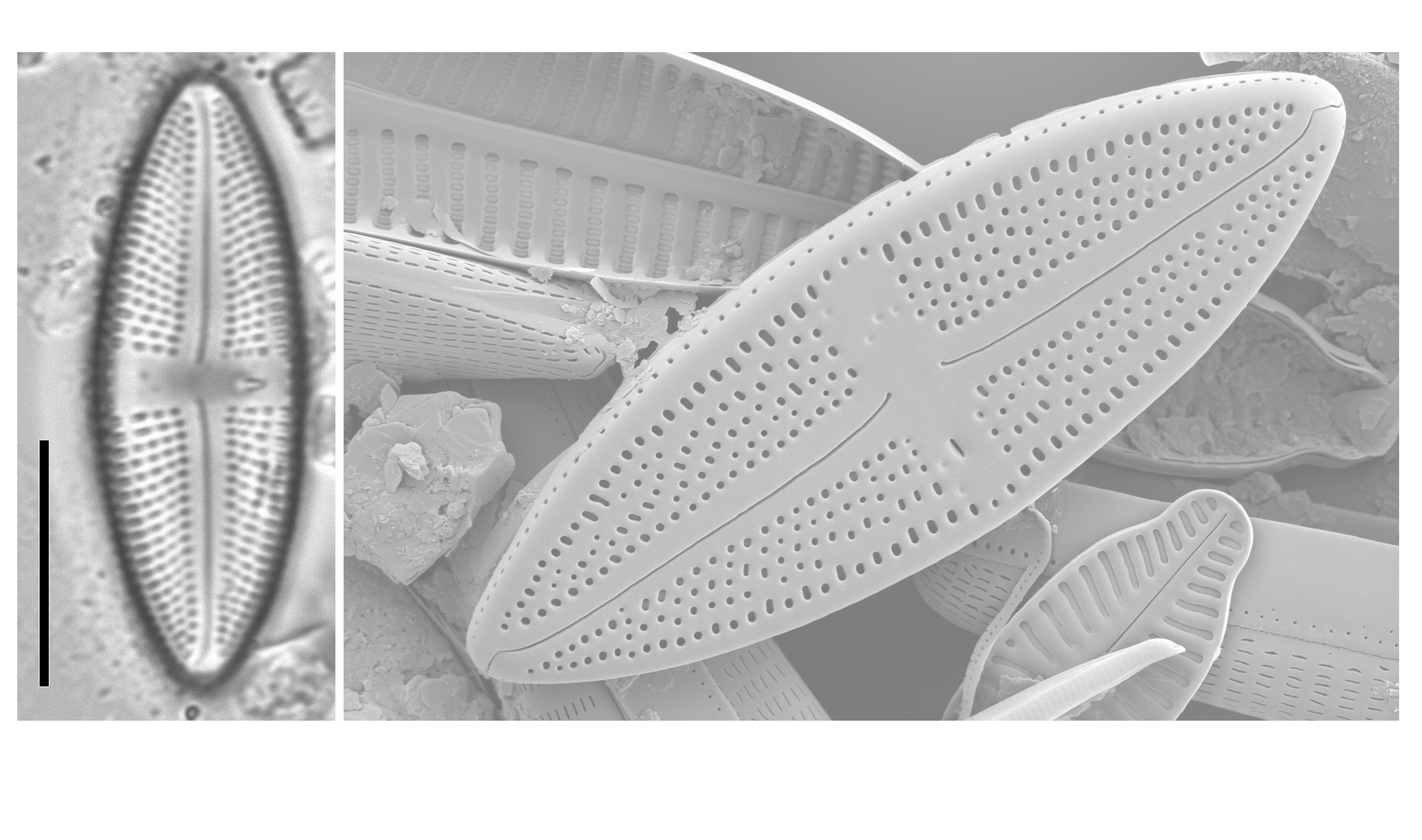Luticola D.G.Mann; 1990; 670
Key references
Levkov Z., Metzeltin D., Pavlov A. 2013. Luticola and Luticolopsis. Vol. 7. Diatoms of Europe. 697 pp
Morphology
Frustules lanceolate, rhombic, elliptical, linear-lanceolate or with undulate margins in valve view, with bluntly rounded, cuneate, rostrate or capitate poles.
Frustules isovalvar, isopolar and bilaterally symmetrical; cells lying in valve and in girdle view.
Striae uniseriate, slightly or strongly radial, coarsely areolate (relative to the small to medium size of most species), interrupted at the junction of valve face and mantle; areolae circular or transapically elongate, occluded by fine pore plates (hymenes), which form a more or less continuous strip along the inner face of each stria. At least in some, there is a longitudinal canal in the wall of the valve at the junction of valve face and mantle.
Axial area narrow. Central area strongly developed, extending to close to the edge of the valve face in many cases, as a broad plain area (fascia); on one side (the secondary side) the area usually contains a special pore (stigma), which has a simple round aperture externally and opens internally via a lipped structure that somewhat resembles a rimoportula.
Raphe straight, curving slightly towards one side (the primary side) at the centre; central external raphe endings simple or deflected; internal central raphe endings straight; terminal fissures bent or hooked.
Girdle composed of several narrow bands. One complex chloroplast per cell, consisting of two lobed plates against the valves, connected by a bridge containing a prominent pyrenoid.
Frustules isovalvar, isopolar and bilaterally symmetrical; cells lying in valve and in girdle view.
Striae uniseriate, slightly or strongly radial, coarsely areolate (relative to the small to medium size of most species), interrupted at the junction of valve face and mantle; areolae circular or transapically elongate, occluded by fine pore plates (hymenes), which form a more or less continuous strip along the inner face of each stria. At least in some, there is a longitudinal canal in the wall of the valve at the junction of valve face and mantle.
Axial area narrow. Central area strongly developed, extending to close to the edge of the valve face in many cases, as a broad plain area (fascia); on one side (the secondary side) the area usually contains a special pore (stigma), which has a simple round aperture externally and opens internally via a lipped structure that somewhat resembles a rimoportula.
Raphe straight, curving slightly towards one side (the primary side) at the centre; central external raphe endings simple or deflected; internal central raphe endings straight; terminal fissures bent or hooked.
Girdle composed of several narrow bands. One complex chloroplast per cell, consisting of two lobed plates against the valves, connected by a bridge containing a prominent pyrenoid.
Literature
References are given in chronological order.
Reference |
Citation |
|---|---|
| Round F.E., Crawford R.M., Mann D.G. 1990. The Diatoms. Biology & Morphology of the Genera. Cambridge University Press, Cambridge. 747 pp | Morphology; Taxonomy; Description |
| Metzeltin D., Lange-Bertalot H. 2007. Tropical diatoms of South America II. Special remarks on biogeography disjunction. Iconographia Diatomologica, Vol. 18., Annotated Diatom Micrographs. Diversity-Taxonomy-Biogeography. H. Lange-Bertalot (ed.), A.R.G. Gantner Verlag K.G. 877 pp | Morphology; Taxonomy; Illustrations |
| Kopalová K., Nedbalová L. de Haan M., Van de Vijver B. 2011. Description of five new species of the diatom genus Luticola (Bacillariophyta, Diadesmidaceae) found in lakes of James Ross Island (Maritime Antarctic Region). Phytotaxa. 27: 44-60. | Morphology; Taxonomy; Illustrations |
| Levkov Z., Metzeltin D., Pavlov A. 2013. Luticola and Luticolopsis. Vol. 7. Diatoms of Europe. 697 pp | Morphology; Taxonomy; Illustrations |
| Kohler T.J.,Kopalova K., Van De Vijver B., Kociolek J.P. 2015. The genus Luticola DG Mann (Bacillariophyta) from the McMurdo Sound Region, Antarctica, with the description of four new species. Phytotaxa. 208(2): 103-134. | Morphology; Illustrations; Taxonomy |
This page should be cited as:
Mann D. G. Luticola D.G.Mann; 1990; 670. In: Jüttner I., Carter C., Cox E.J., Ector L., Jones V., Kelly M.G., Kennedy B., Mann D.G., Turner J. A., Van de Vijver B., Wetzel C.E., Williams D.M..
Freshwater Diatom Flora of Britain and Ireland. Amgueddfa Cymru - National Museum Wales. Available online at https://naturalhistory.museumwales.ac.uk/diatoms/browsespecies.php?-recid=3631. [Accessed:
].
Record last modified: 27/12/2020


